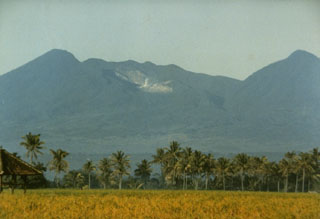Report on Papandayan (Indonesia) — 9 April-15 April 2008
Smithsonian Institution / US Geological Survey
Weekly Volcanic Activity Report, 9 April-15 April 2008
Managing Editor: Sally Sennert.
Please cite this report as:
Global Volcanism Program, 2008. Report on Papandayan (Indonesia) (Sennert, S, ed.). Weekly Volcanic Activity Report, 9 April-15 April 2008. Smithsonian Institution and US Geological Survey.
Papandayan
Indonesia
7.32°S, 107.73°E; summit elev. 2665 m
All times are local (unless otherwise noted)
CVGHM reported that the seismic network recorded one volcanic tremor signal from Papandayan on 15 April. On 16 April, measurements of summit fumaroles revealed an increase in temperature and changes in water chemistry since 7 April. White plumes continued to rise to an altitude of 2.7 km (8,900 ft) a.s.l. and did not change. CVGHM increased the Alert Level to 2 (on a scale of 1-4) and reminded visitors and residents not to venture within 1 km of the active crater.
Geological Summary. Papandayan is a complex stratovolcano with four large summit craters, the youngest of which was breached to the NE by collapse during a brief eruption in 1772 and contains active fumarole fields. The broad 1.1-km-wide, flat-floored Alun-Alun crater truncates the summit of Papandayan, and Gunung Puntang to the north gives a twin-peaked appearance. Several episodes of collapse have created an irregular profile and produced debris avalanches that have impacted lowland areas. A sulfur-encrusted fumarole field occupies historically active Kawah Mas ("Golden Crater"). After its first historical eruption in 1772, in which collapse of the NE flank produced a catastrophic debris avalanche that destroyed 40 villages and killed nearly 3000 people, only small phreatic eruptions had occurred prior to an explosive eruption that began in November 2002.
Source: Pusat Vulkanologi dan Mitigasi Bencana Geologi (PVMBG, also known as CVGHM)

